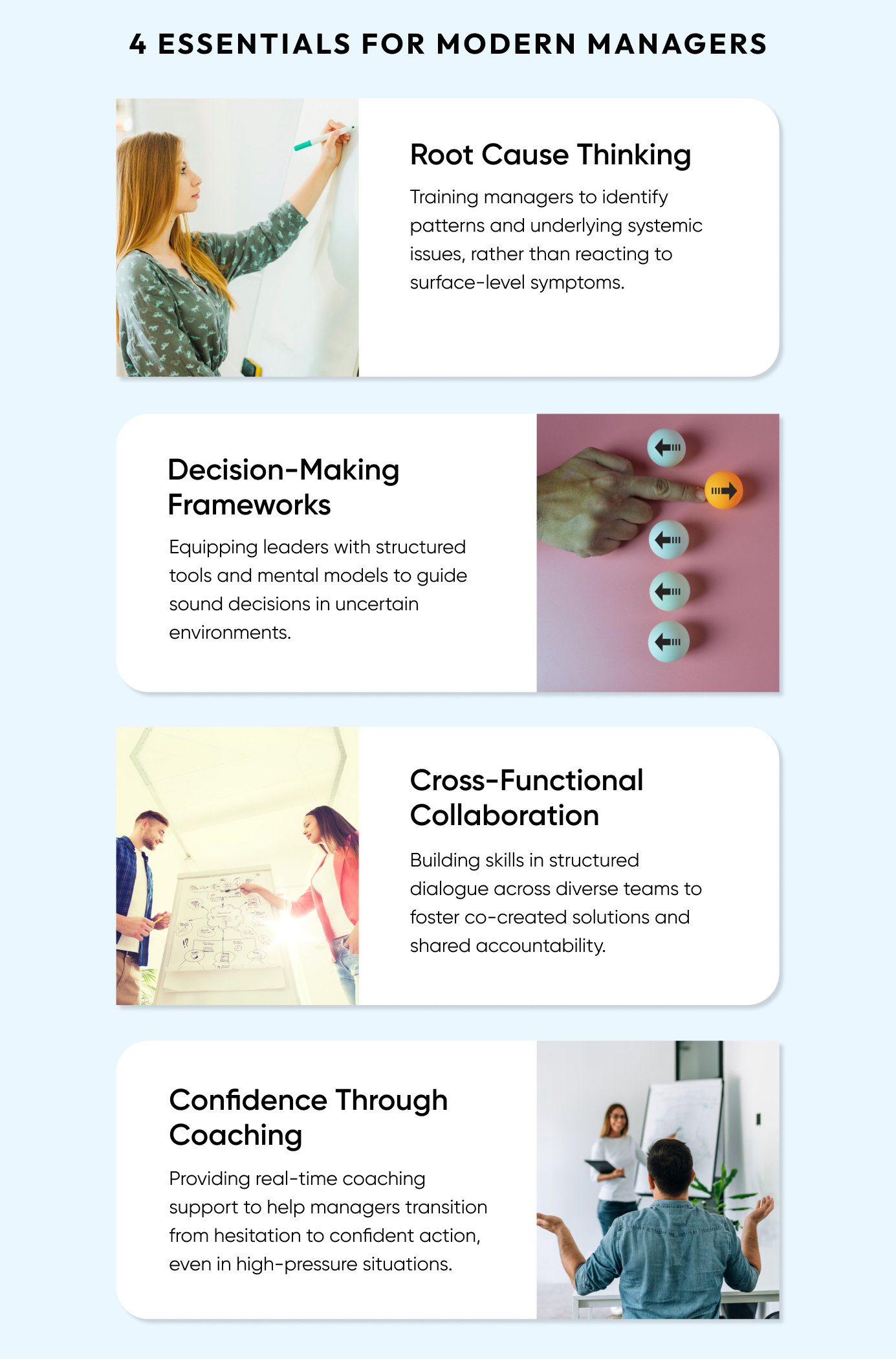Confident Decision-Makers Drive Business

Why Developing Mid-Level Problem Solvers Is a Strategic Imperative
Every day, mid-level managers make decisions that shape how organizations function — from how teams are staffed and projects prioritized, to how resources are allocated and cross-functional communication is handled. These aren’t just task-level choices; they are the connective tissue between strategy and execution. In real terms, that means choosing what gets built, which voices get heard, and how quickly and effectively a company can adapt.
Some decisions are routine. Others — masked as status updates, budget shifts, or team assignments — are actually strategic inflection points in disguise.
What unites them all is uncertainty. Managers operate without perfect clarity, often under shifting priorities, evolving client demands, or internal ambiguity. Their ability to navigate this complexity has an outsized impact on delivery timelines, team morale, and client trust.
Execution may earn the promotion, but discernment sustains leadership. Yet too often, managers are left without the tools to:
- Diagnose root causes of persistent issues
- Weigh trade-offs between competing priorities
- Balance decisiveness with inclusive, context-aware thinking
Instead, they default to:
- Over-escalation that clogs decision-making channels
- Delays driven by analysis paralysis or lack of ownership
- Misalignment and rework caused by knee-jerk, siloed decisions
The result? Execution suffers — ironically, from a lack of deeper thinking.

The Strategic Cost of Hesitation — and Haste
When mid-level decision-making is weak, the business doesn’t just suffer operationally — it bleeds strategically.
Hesitation: The Hidden Drag on Strategic Momentum
Managers who delay decisions often do so out of fear — fear of making the wrong call, stepping on toes, or exposing gaps. But at scale, hesitation becomes inertia:
- Strategic initiatives stall
- Teams lose alignment and autonomy
- Opportunities are missed while competitors move ahead
In today’s volatile markets, indecision isn’t neutral — it’s expensive.
Haste: The Shortcut That Creates Strategic Debt
At the other extreme, some managers leap into action without fully considering implications:
- Quick fixes misfire due to lack of stakeholder alignment
- Rework drains capacity and morale
- Friction increases as decisions collide downstream
This creates strategic debt — choices that solve short-term tension but accrue long-term costs in trust, coherence, and agility.
Without the skills to think systemically, even well-intended managers become a source of friction, not flow.
Equipping Managers to Lead Through Ambiguity
At Axelerant People, we've drawn from our experience in designing leadership development initiatives and identified essential learning components that directly address the challenges of ambiguity. A thoughtfully curated mix of coaching, problem-solving frameworks, and collaborative simulations helps managers shift from a reactive mindset to a more resourceful and proactive approach.

With the rise of AI, managers also need to learn to engage AI agents as partners in the decision-making process, leveraging their insights while still owning the responsibility and final judgment.
Intentional Development for Impactful Leadership
For reporting managers and organizational leaders: If your teams are weighed down by decision delays, frequent escalations, or recurring misjudgments, the core issue may not be motivation. It could be a gap in problem-solving and decision-making capability.
And for managers themselves: If you often feel stuck, second-guess your choices, or default to escalation when things get messy, you’re not alone. The good news? These are skills you can develop to navigate uncertainty with greater clarity and confidence.
Investing in structured development through diverse learning mechanisms doesn’t just create stronger decision-makers. It drives better business outcomes and the long-sought business impact.
Because in today’s world, speed and strategy must go hand in hand. And confident, capable managers are the key catalysts.
Here’s a tool designed to get you thinking about your mid-level managers’ decision-making capabilities. Use it as a framework to reflect on the type of support your leaders may need to strengthen and refine their decision-making skills. And if you'd like to start a conversation, please click here.

.jpg)


